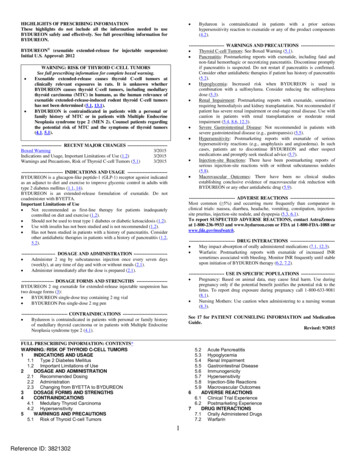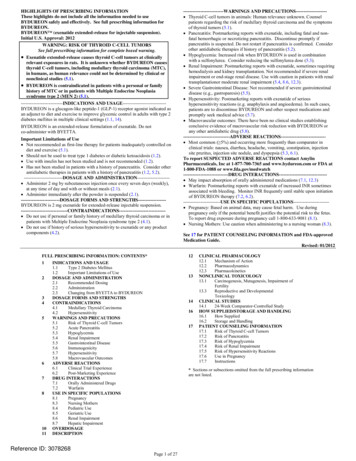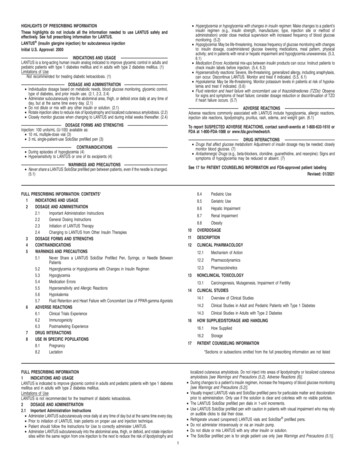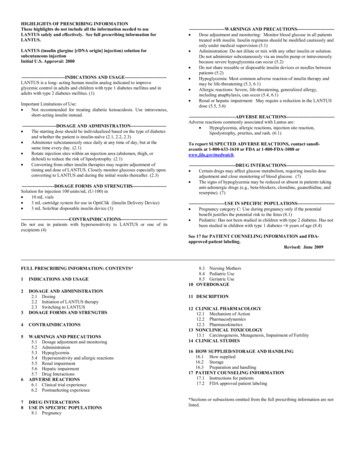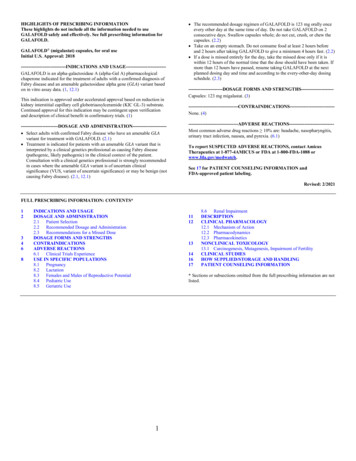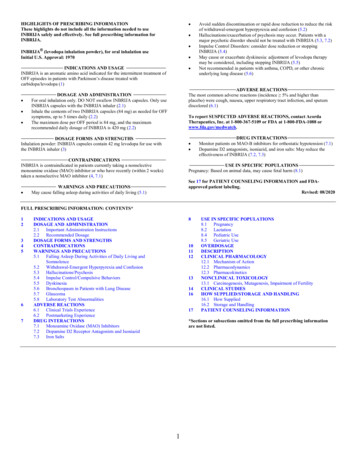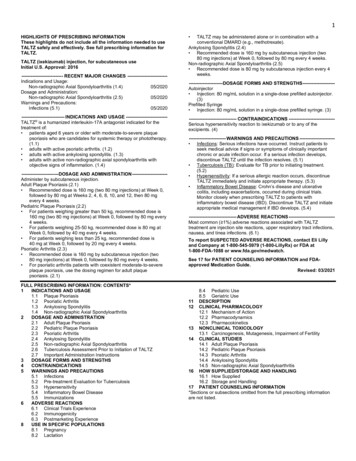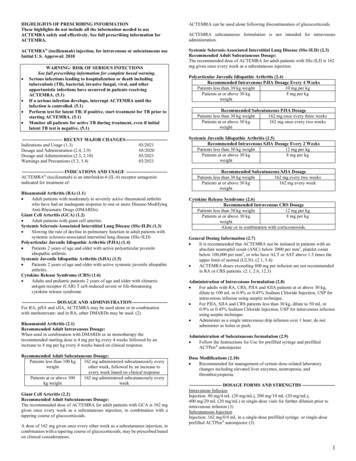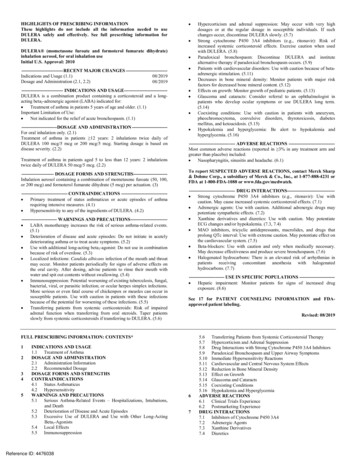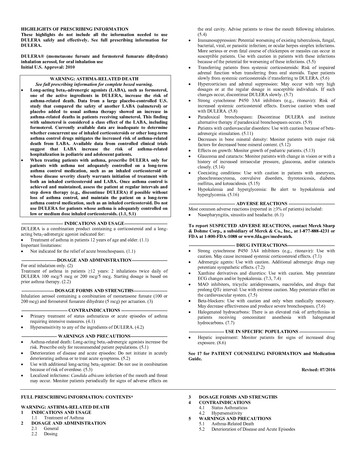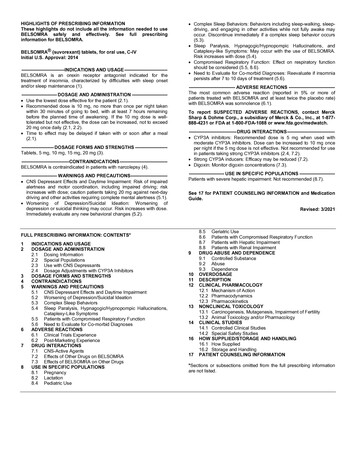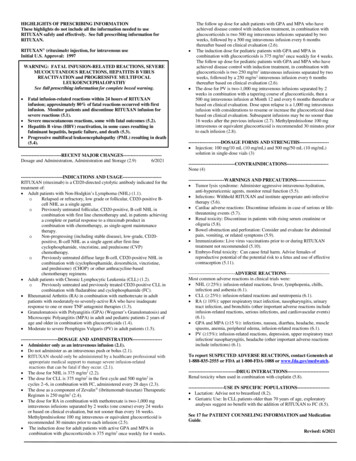
Transcription
HIGHLIGHTS OF PRESCRIBING INFORMATIONThese highlights do not include all the information needed to useRITUXAN safely and effectively. See full prescribing information forRITUXAN.RITUXAN (rituximab) injection, for intravenous useInitial U.S. Approval: 1997WARNING: FATAL INFUSION-RELATED REACTIONS, SEVEREMUCOCUTANEOUS REACTIONS, HEPATITIS B VIRUSREACTIVATION and PROGRESSIVE MULTIFOCALLEUKOENCEPHALOPATHYSee full prescribing information for complete boxed warning. Fatal infusion-related reactions within 24 hours of RITUXANinfusion; approximately 80% of fatal reactions occurred with firstinfusion. Monitor patients and discontinue RITUXAN infusion forsevere reactions (5.1).Severe mucocutaneous reactions, some with fatal outcomes (5.2).Hepatitis B virus (HBV) reactivation, in some cases resulting infulminant hepatitis, hepatic failure, and death (5.3).Progressive multifocal leukoencephalopathy (PML) resulting in death(5.4).--------------------------RECENT MAJOR CHANGES------------------------Dosage and Administration, Administration and Storage (2.9)6/2021---------------------------INDICATIONS AND USAGE------------------------RITUXAN (rituximab) is a CD20-directed cytolytic antibody indicated for thetreatment of: Adult patients with Non-Hodgkin’s Lymphoma (NHL) (1.1).oRelapsed or refractory, low grade or follicular, CD20-positive Bcell NHL as a single agent.oPreviously untreated follicular, CD20-positive, B-cell NHL incombination with first line chemotherapy and, in patients achievinga complete or partial response to a rituximab product incombination with chemotherapy, as single-agent maintenancetherapy.oNon-progressing (including stable disease), low-grade, CD20positive, B-cell NHL as a single agent after first-linecyclophosphamide, vincristine, and prednisone (CVP)chemotherapy.oPreviously untreated diffuse large B-cell, CD20-positive NHL incombination with (cyclophosphamide, doxorubicin, vincristine,and prednisone) (CHOP) or other anthracycline-basedchemotherapy regimens. Adult patients with Chronic Lymphocytic Leukemia (CLL) (1.2).oPreviously untreated and previously treated CD20-positive CLL incombination with fludarabine and cyclophosphamide (FC). Rheumatoid Arthritis (RA) in combination with methotrexate in adultpatients with moderately-to severely-active RA who have inadequateresponse to one or more TNF antagonist therapies (1.3). Granulomatosis with Polyangiitis (GPA) (Wegener’s Granulomatosis) andMicroscopic Polyangiitis (MPA) in adult and pediatric patients 2 years ofage and older in combination with glucocorticoids (1.4). Moderate to severe Pemphigus Vulgaris (PV) in adult patients (1.5).------------------------DOSAGE AND ADMINISTRATION------------------ Administer only as an intravenous infusion (2.1). Do not administer as an intravenous push or bolus (2.1). RITUXAN should only be administered by a healthcare professional withappropriate medical support to manage severe infusion-relatedreactions that can be fatal if they occur. (2.1). The dose for NHL is 375 mg/m2 (2.2). The dose for CLL is 375 mg/m2 in the first cycle and 500 mg/m2 incycles 2 6, in combination with FC, administered every 28 days (2.3). The dose as a component of Zevalin (ibritumomab tiuxetan) TherapeuticRegimen is 250 mg/m2 (2.4). The dose for RA in combination with methotrexate is two-1,000 mgintravenous infusions separated by 2 weeks (one course) every 24 weeksor based on clinical evaluation, but not sooner than every 16 weeks.Methylprednisolone 100 mg intravenous or equivalent glucocorticoid isrecommended 30 minutes prior to each infusion (2.5). The induction dose for adult patients with active GPA and MPA incombination with glucocorticoids is 375 mg/m2 once weekly for 4 weeks. The follow up dose for adult patients with GPA and MPA who haveachieved disease control with induction treatment, in combination withglucocorticoids is two 500 mg intravenous infusions separated by twoweeks, followed by a 500 mg intravenous infusion every 6 monthsthereafter based on clinical evaluation (2.6).The induction dose for pediatric patients with GPA and MPA incombination with glucocorticoids is 375 mg/m2 once weekly for 4 weeks.The follow up dose for pediatric patients with GPA and MPA who haveachieved disease control with induction treatment, in combination withglucocorticoids is two 250 mg/m2 intravenous infusions separated by twoweeks, followed by a 250 mg/m2 intravenous infusion every 6 monthsthereafter based on clinical evaluation (2.6).The dose for PV is two-1,000 mg intravenous infusions separated by 2weeks in combination with a tapering course of glucocorticoids, then a500 mg intravenous infusion at Month 12 and every 6 months thereafter orbased on clinical evaluation. Dose upon relapse is a 1,000 mg intravenousinfusion with considerations to resume or increase the glucocorticoid dosebased on clinical evaluation. Subsequent infusions may be no sooner than16 weeks after the previous infusion (2.7). Methylprednisolone 100 mgintravenous or equivalent glucocorticoid is recommended 30 minutes priorto each infusion (2.8).---------------------DOSAGE FORMS AND STRENGTHS------------------ Injection: 100 mg/10 mL (10 mg/mL) and 500 mg/50 mL (10 mg/mL)solution in single-dose vials --------------------------None (4)-----------------------WARNINGS AND PRECAUTIONS------------------ Tumor lysis syndrome: Administer aggressive intravenous hydration,anti-hyperuricemic agents, monitor renal function (5.5). Infections: Withhold RITUXAN and institute appropriate anti-infectivetherapy (5.6). Cardiac adverse reactions: Discontinue infusions in case of serious or lifethreatening events (5.7). Renal toxicity: Discontinue in patients with rising serum creatinine oroliguria (5.8). Bowel obstruction and perforation: Consider and evaluate for abdominalpain, vomiting, or related symptoms (5.9). Immunizations: Live virus vaccinations prior to or during RITUXANtreatment not recommended (5.10). Embryo-Fetal toxicity: Can cause fetal harm. Advise females ofreproductive potential of the potential risk to a fetus and use of effectivecontraception (5.11).------------------------------ADVERSE REACTIONS---------------------------Most common adverse reactions in clinical trials were: NHL ( 25%): infusion-related reactions, fever, lymphopenia, chills,infection and asthenia (6.1). CLL ( 25%): infusion-related reactions and neutropenia (6.1). RA ( 10%): upper respiratory tract infection, nasopharyngitis, urinarytract infection, and bronchitis (other important adverse reactions includeinfusion-related reactions, serious infections, and cardiovascular events)(6.1). GPA and MPA ( 15 %): infections, nausea, diarrhea, headache, musclespasms, anemia, peripheral edema, infusion-related reactions (6.1). PV ( 15%): infusion-related reactions, depression, upper respiratory tractinfection/ nasopharyngitis, headache (other important adverse reactionsinclude infections) (6.1).To report SUSPECTED ADVERSE REACTIONS, contact Genentech at1-888-835-2555 or FDA at 1-800-FDA-1088 or --DRUG INTERACTIONS--------------------------Renal toxicity when used in combination with cisplatin (5.8).-----------------------USE IN SPECIFIC POPULATIONS-------------------- Lactation: Advise not to breastfeed (8.2). Geriatric Use: In CLL patients older than 70 years of age, exploratoryanalyses suggest no benefit with the addition of RITUXAN to FC (8.5).See 17 for PATIENT COUNSELING INFORMATION and MedicationGuide.Revised: 6/2021
5.12FULL PRESCRIBING INFORMATION: CONTENTS*WARNING: FATAL INFUSION-RELATED REACTIONS,SEVERE MUCOCUTANEOUS REACTIONS, HEPATITISB VIRUS REACTIVATION and PROGRESSIVEMULTIFOCAL LEUKOENCEPHALOPATHY1 INDICATIONS AND USAGE1.1Non-Hodgkin’s Lymphoma (NHL)1.2Chronic Lymphocytic Leukemia (CLL)1.3Rheumatoid Arthritis (RA)1.4Granulomatosis with Polyangiitis (GPA) (Wegener’sGranulomatosis) and Microscopic Polyangiitis (MPA)1.5Pemphigus Vulgaris (PV)2 DOSAGE AND ADMINISTRATION2.1Important Dosing Information2.2Recommended Dose for Non-Hodgkin’s Lymphoma(NHL)2.3Recommended Dose for Chronic LymphocyticLeukemia (CLL)2.4Recommended Dose as a Component of Zevalin fortreatment of NHL2.5Recommended Dose for Rheumatoid Arthritis (RA)2.6Recommended Dose for Granulomatosis withPolyangiitis (GPA) (Wegener’s Granulomatosis) andMicroscopic Polyangiitis (MPA)2.7Recommended Dose for Pemphigus Vulgaris (PV)2.8Recommended Dose for Premedication andProphylactic Medications2.9Administration and Storage3 DOSAGE FORMS AND STRENGTHS4 CONTRAINDICATIONS5 WARNINGS AND PRECAUTIONS5.1Infusion-Related Reactions5.2Severe Mucocutaneous Reactions5.3Hepatitis B Virus (HBV) Reactivation5.4Progressive Multifocal Leukoencephalopathy (PML)5.5Tumor Lysis Syndrome (TLS)5.6Infections5.7Cardiovascular Adverse Reactions5.8Renal Toxicity5.9Bowel Obstruction and Perforation5.10 Immunization5.11 Embryo-Fetal Toxicity678111213141617*Concomitant Use with Other Biologic Agents andDMARDS other than Methotrexate in RA, GPA andMPA, PV5.13 Use in RA Patients Who Have Not Had PriorInadequate Response to Tumor Necrosis Factor(TNF) AntagonistsADVERSE REACTIONS6.1Clinical Trials Experience6.2Immunogenicity6.3Postmarketing ExperienceDRUG INTERACTIONSUSE IN SPECIFIC POPULATIONS8.1Pregnancy8.2Lactation8.3Females and Males of Reproductive Potential8.4Pediatric Use8.5Geriatric UseDESCRIPTIONCLINICAL PHARMACOLOGY12.1 Mechanism of Action12.2 Pharmacodynamics12.3 PharmacokineticsNONCLINICAL TOXICOLOGY13.1 Carcinogenesis, Mutagenesis, Impairment of FertilityCLINICAL STUDIES14.1 Relapsed or Refractory, Low-Grade or Follicular,CD20-Positive, B-Cell NHL14.2 Previously Untreated, Low-Grade or Follicular,CD20-Positive, B-Cell NHL14.3 Diffuse Large B-Cell NHL (DLBCL)14.4 Ninety-Minute Infusions in Previously UntreatedFollicular NHL and DLBCL14.5 Chronic Lymphocytic Leukemia (CLL)14.6 Rheumatoid Arthritis (RA)14.7 Granulomatosis with Polyangiitis (GPA) (Wegener’sGranulomatosis) and Microscopic Polyangiitis (MPA)14.8 Pemphigus Vulgaris (PV)HOW SUPPLIED/STORAGE AND HANDLINGPATIENT COUNSELING INFORMATIONSections or subsections omitted from the full prescribing information arenot listed.
FULL PRESCRIBING INFORMATIONWARNING: FATAL INFUSION-RELATED REACTIONS, SEVERE MUCOCUTANEOUSREACTIONS, HEPATITIS B VIRUS REACTIVATION and PROGRESSIVEMULTIFOCAL LEUKOENCEPHALOPATHYInfusion-Related ReactionsRITUXAN administration can result in serious, including fatal, infusion-related reactions.Deaths within 24 hours of RITUXAN infusion have occurred. Approximately 80% of fatalinfusion reactions occurred in association with the first infusion. Monitor patients closely.Discontinue RITUXAN infusion for severe reactions and provide medical treatment for Grade3 or 4 infusion-related reactions [see Warnings and Precautions (5.1), Adverse Reactions (6.1)].Severe Mucocutaneous ReactionsSevere, including fatal, mucocutaneous reactions can occur in patients receiving RITUXAN[see Warnings and Precautions (5.2)].Hepatitis B Virus (HBV) ReactivationHBV reactivation can occur in patients treated with RITUXAN, in some cases resulting infulminant hepatitis, hepatic failure, and death. Screen all patients for HBV infection beforetreatment initiation, and monitor patients during and after treatment with RITUXAN.Discontinue RITUXAN and concomitant medications in the event of HBV reactivation [seeWarnings and Precautions (5.3)].Progressive Multifocal Leukoencephalopathy (PML), including fatal PML, can occur inpatients receiving RITUXAN [see Warnings and Precautions (5.4) and Adverse Reactions (6.1)].1INDICATIONS AND USAGE1.1Non–Hodgkin’s Lymphoma (NHL)RITUXAN (rituximab) is indicated for the treatment of adult patients with: Relapsed or refractory, low-grade or follicular, CD20-positive, B-cell NHL as a single agent.Previously untreated follicular, CD20-positive, B-cell NHL in combination with first linechemotherapy and, in patients achieving a complete or partial response to a rituximab productin combination with chemotherapy, as single-agent maintenance therapy. Non-progressing (including stable disease), low-grade, CD20-positive, B-cell NHL as a singleagent after first-line cyclophosphamide, vincristine, and prednisone (CVP) chemotherapy. Previously untreated diffuse large B-cell, CD20-positive NHL in combination withcyclophosphamide, doxorubicin, vincristine, prednisone (CHOP) or other anthracycline-basedchemotherapy regimens.1.2Chronic Lymphocytic Leukemia (CLL)RITUXAN, in combination with fludarabine and cyclophosphamide (FC), is indicated for thetreatment of adult patients with previously untreated and previously treated CD20-positive CLL.1.3Rheumatoid Arthritis (RA)RITUXAN, in combination with methotrexate, is indicated for the treatment of adult patients withmoderately- to severely-active rheumatoid arthritis who have had an inadequate response to one ormore TNF antagonist therapies.1.4Granulomatosis with Polyangiitis (GPA) (Wegener’s Granulomatosis) and MicroscopicPolyangiitis (MPA)RITUXAN, in combination with glucocorticoids, is indicated for the treatment of adult andpediatric patients 2 years of age and older with Granulomatosis with Polyangiitis (GPA) (Wegener’sGranulomatosis) and Microscopic Polyangiitis (MPA).
1.5Pemphigus Vulgaris (PV)RITUXAN is indicated for the treatment of adult patients with moderate to severe pemphigusvulgaris.2DOSAGE AND ADMINISTRATION2.1Important Dosing InformationAdminister only as an Intravenous Infusion [see Dosage and Administration (2.8)]. Do notadminister as an intravenous push or bolus.RITUXAN should only be administered by a healthcare professional with appropriate medicalsupport to manage severe infusion-related reactions that can be fatal if they occur [see Warnings andPrecautions (5.1)].Premedicate before each infusion [see Dosage and Administration (2.8)].Prior to First Infusion: Screen all patients for HBV infection by measuring HBsAg and anti-HBcbefore initiating treatment with RITUXAN [see Warnings and Precautions (5.3)]. Obtain completeblood counts (CBC) including platelets prior to the first dose.During RITUXAN Therapy: In patients with lymphoid malignancies, during treatment withRITUXAN monotherapy, obtain complete blood counts (CBC) with differential and platelet countsprior to each RITUXAN course. During treatment with RITUXAN and chemotherapy, obtain CBCwith differential and platelet counts at weekly to monthly intervals and more frequently in patientswho develop cytopenias [see Adverse Reactions (6.1)]. In patients with RA, GPA or MPA, obtainCBC with differential and platelet counts at two to four month intervals during RITUXAN therapy.Continue to monitor for cytopenias after final dose and until resolution. First Infusion: Initiate infusion at a rate of 50 mg/hr. In the absence of infusion toxicity,increase infusion rate by 50 mg/hr increments every 30 minutes, to a maximum of 400 mg/hr. Subsequent Infusions:Standard Infusion: Initiate infusion at a rate of 100 mg/hr. In the absence of infusion toxicity,increase rate by 100 mg/hr increments at 30-minute intervals, to a maximum of 400 mg/hr.For Previously Untreated Follicular NHL and DLBCL patients:If patients did not experience a Grade 3 or 4 infusion-related adverse event during Cycle 1, a90-minute infusion can be administered in Cycle 2 with a glucocorticoid-containingchemotherapy regimen.Initiate at a rate of 20% of the total dose given in the first 30 minutes and the remaining 80%of the total dose given over the next 60 minutes. If the 90-minute infusion is tolerated inCycle 2, the same rate can be used when administering the remainder of the treatment regimen(through Cycle 6 or 8).Patients who have clinically significant cardiovascular disease or who have a circulatinglymphocyte count 5,000/mm3 before Cycle 2 should not be administered the 90-minuteinfusion [see Clinical Studies (14.4)]. Interrupt the infusion or slow the infusion rate for infusion-related reactions [seeBoxed Warning, Warnings and Precautions (5.1)]. Continue the infusion at one-half theprevious rate upon improvement of symptoms.2.2Recommended Dose for Non-Hodgkin’s Lymphoma (NHL)The recommended dose is 375 mg/m2 as an intravenous infusion according to the followingschedules: Relapsed or Refractory, Low-Grade or Follicular, CD20-Positive, B-Cell NHLAdminister once weekly for 4 or 8 doses.
Retreatment for Relapsed or Refractory, Low-Grade or Follicular, CD20-Positive,B-Cell NHLAdminister once weekly for 4 doses. Previously Untreated, Follicular, CD20-Positive, B-Cell NHLAdminister on Day 1 of each cycle of chemotherapy for up to 8 doses. In patients withcomplete or partial response, initiate RITUXAN maintenance eight weeks followingcompletion of a rituximab product in combination with chemotherapy. AdministerRITUXAN as a single-agent every 8 weeks for 12 doses. Non-progressing, Low-Grade, CD20-Positive, B-Cell NHL, after first-line CVPchemotherapyFollowing completion of 6 8 cycles of CVP chemotherapy, administer once weekly for4 doses at 6-month intervals to a maximum of 16 doses. Diffuse Large B-Cell NHLAdminister on Day 1 of each cycle of chemotherapy for up to 8 infusions.2.3Recommended Dose for Chronic Lymphocytic Leukemia (CLL)The recommended dose is 375 mg/m2 the day prior to the initiation of FC chemotherapy, then500 mg/m2 on Day 1 of cycles 2 6 (every 28 days).2.4Recommended Dose as a Component of Zevalin for treatment of NHL When used as part of the Zevalin therapeutic regimen, infuse 250 mg/m2 in accordance withthe Zevalin package insert. Refer to the Zevalin package insert for full prescribing informationregarding the Zevalin therapeutic regimen.2.5Recommended Dose for Rheumatoid Arthritis (RA) Administer RITUXAN as two-1,000 mg intravenous infusions separated by 2 weeks. Glucocorticoids administered as methylprednisolone 100 mg intravenous or its equivalent30 minutes prior to each infusion are recommended to reduce the incidence and severity ofinfusion-related reactions. Subsequent courses should be administered every 24 weeks or based on clinical evaluation,but not sooner than every 16 weeks. RITUXAN is given in combination with methotrexate.2.6Recommended Dose for Granulomatosis with Polyangiitis (GPA) (Wegener’sGranulomatosis) and Microscopic Polyangiitis (MPA)Induction Treatment of Adult Patients with Active GPA/MPA Administer RITUXAN as a 375 mg/m2 intravenous infusion once weekly for 4 weeks forpatients with active GPA or MPA. Glucocorticoids administered as methylprednisolone 1,000 mg intravenously per day for 1 to3 days followed by oral prednisone as per clinical practice. This regimen should begin within14 days prior to or with the initiation of RITUXAN and may continue during and after the 4week induction course of RITUXAN treatment.Follow up Treatment of Adult Patients with GPA/MPA who have achieved disease controlwith induction treatment Administer RITUXAN as two 500 mg intravenous infusions separated by two weeks,followed by a 500 mg intravenous infusion every 6 months thereafter based on clinicalevaluation. If induction treatment of active disease was with a rituximab product, initiate follow uptreatment with RITUXAN within 24 weeks after the last induction infusion with a rituximabproduct or based on clinical evaluation, but no sooner than 16 weeks after the last inductioninfusion with a rituximab product.
If induction treatment of active disease was with other standard of care immunosuppressants,initiate RITUXAN follow up treatment within the 4 week period that follows achievement ofdisease control.Induction treatment of Pediatric Patients with Active GPA/MPA Administer RITUXAN as a 375 mg/m2 intravenous infusion once weekly for 4 weeks. Prior to the first RITUXAN infusion, administer intravenous methylprednisolone 30 mg/kg(not to exceed 1g/day) once daily for 3 days. Following intravenous methylprednisolone administration, oral st
Dosage and Administration, GPA and MPA (2.6) 09/2019. Warnings and Precautions, Immunization (5.10) 09/2019 -----INDICATIONS AND USAGE----- RITUXAN (rituximab) is a CD20-directed cytolytic antibody indicated for the treatment of: Ad
